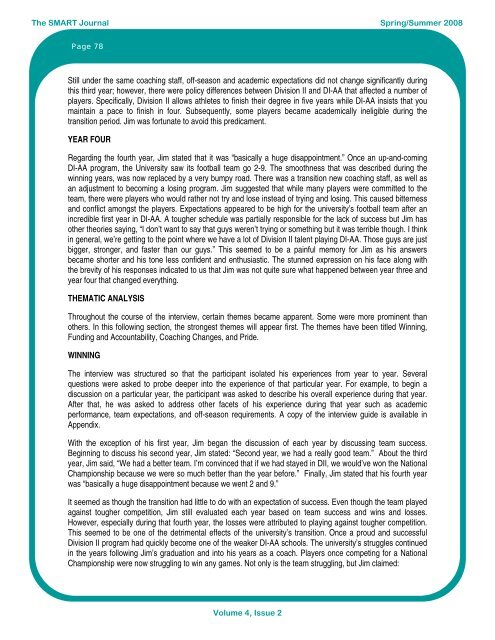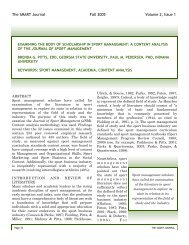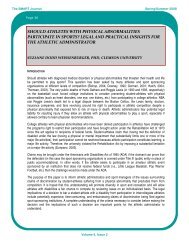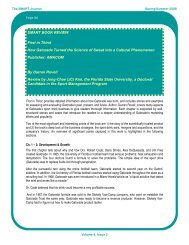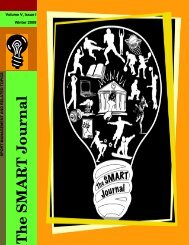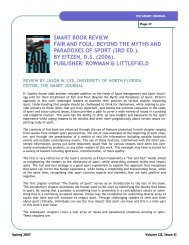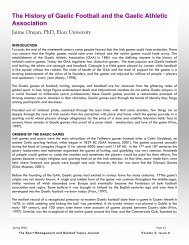Spring/Summer 2008 Volume 4, Issue 2 - The SMART Journal
Spring/Summer 2008 Volume 4, Issue 2 - The SMART Journal
Spring/Summer 2008 Volume 4, Issue 2 - The SMART Journal
You also want an ePaper? Increase the reach of your titles
YUMPU automatically turns print PDFs into web optimized ePapers that Google loves.
<strong>The</strong> <strong>SMART</strong> <strong>Journal</strong> <strong>Spring</strong>/<strong>Summer</strong> <strong>2008</strong><br />
Page 78<br />
Still under the same coaching staff, off-season and academic expectations did not change significantly during<br />
this third year; however, there were policy differences between Division II and DI-AA that affected a number of<br />
players. Specifically, Division II allows athletes to finish their degree in five years while DI-AA insists that you<br />
maintain a pace to finish in four. Subsequently, some players became academically ineligible during the<br />
transition period. Jim was fortunate to avoid this predicament.<br />
YEAR FOUR<br />
Regarding the fourth year, Jim stated that it was “basically a huge disappointment.” Once an up-and-coming<br />
DI-AA program, the University saw its football team go 2-9. <strong>The</strong> smoothness that was described during the<br />
winning years, was now replaced by a very bumpy road. <strong>The</strong>re was a transition new coaching staff, as well as<br />
an adjustment to becoming a losing program. Jim suggested that while many players were committed to the<br />
team, there were players who would rather not try and lose instead of trying and losing. This caused bitterness<br />
and conflict amongst the players. Expectations appeared to be high for the university’s football team after an<br />
incredible first year in DI-AA. A tougher schedule was partially responsible for the lack of success but Jim has<br />
other theories saying, “I don’t want to say that guys weren’t trying or something but it was terrible though. I think<br />
in general, we’re getting to the point where we have a lot of Division II talent playing DI-AA. Those guys are just<br />
bigger, stronger, and faster than our guys.” This seemed to be a painful memory for Jim as his answers<br />
became shorter and his tone less confident and enthusiastic. <strong>The</strong> stunned expression on his face along with<br />
the brevity of his responses indicated to us that Jim was not quite sure what happened between year three and<br />
year four that changed everything.<br />
THEMATIC ANALYSIS<br />
Throughout the course of the interview, certain themes became apparent. Some were more prominent than<br />
others. In this following section, the strongest themes will appear first. <strong>The</strong> themes have been titled Winning,<br />
Funding and Accountability, Coaching Changes, and Pride.<br />
WINNING<br />
<strong>The</strong> interview was structured so that the participant isolated his experiences from year to year. Several<br />
questions were asked to probe deeper into the experience of that particular year. For example, to begin a<br />
discussion on a particular year, the participant was asked to describe his overall experience during that year.<br />
After that, he was asked to address other facets of his experience during that year such as academic<br />
performance, team expectations, and off-season requirements. A copy of the interview guide is available in<br />
Appendix.<br />
With the exception of his first year, Jim began the discussion of each year by discussing team success.<br />
Beginning to discuss his second year, Jim stated: “Second year, we had a really good team.” About the third<br />
year, Jim said, “We had a better team. I’m convinced that if we had stayed in DII, we would’ve won the National<br />
Championship because we were so much better than the year before.” Finally, Jim stated that his fourth year<br />
was “basically a huge disappointment because we went 2 and 9.”<br />
It seemed as though the transition had little to do with an expectation of success. Even though the team played<br />
against tougher competition, Jim still evaluated each year based on team success and wins and losses.<br />
However, especially during that fourth year, the losses were attributed to playing against tougher competition.<br />
This seemed to be one of the detrimental effects of the university’s transition. Once a proud and successful<br />
Division II program had quickly become one of the weaker DI-AA schools. <strong>The</strong> university’s struggles continued<br />
in the years following Jim’s graduation and into his years as a coach. Players once competing for a National<br />
Championship were now struggling to win any games. Not only is the team struggling, but Jim claimed:<br />
<strong>Volume</strong> 4, <strong>Issue</strong> 2


